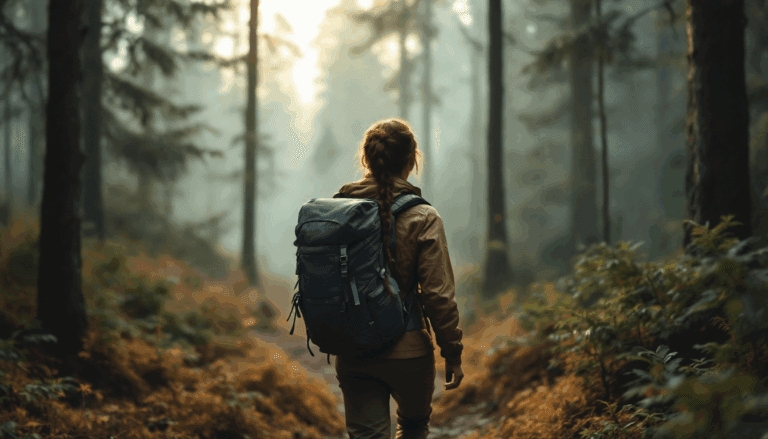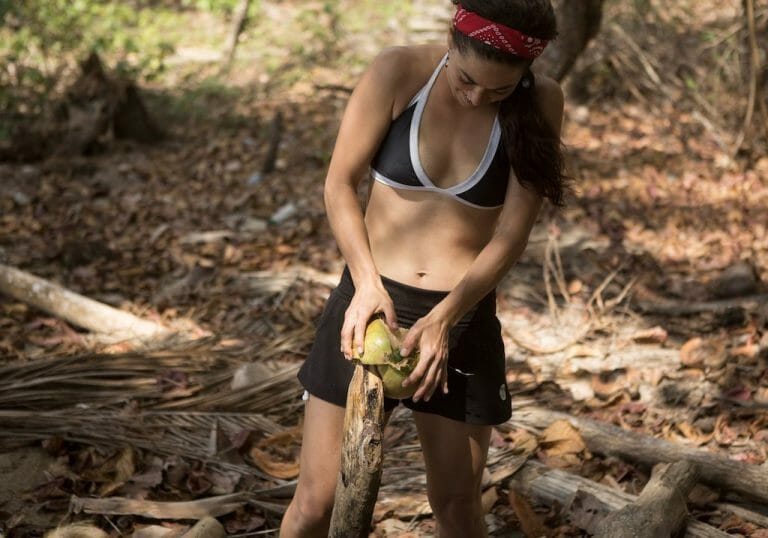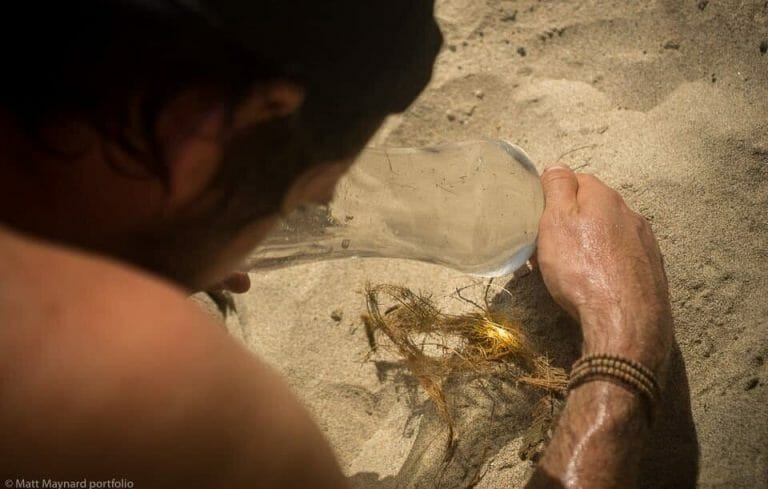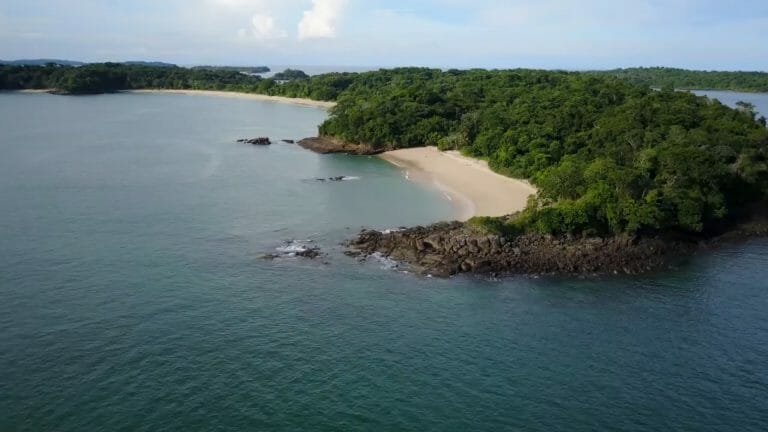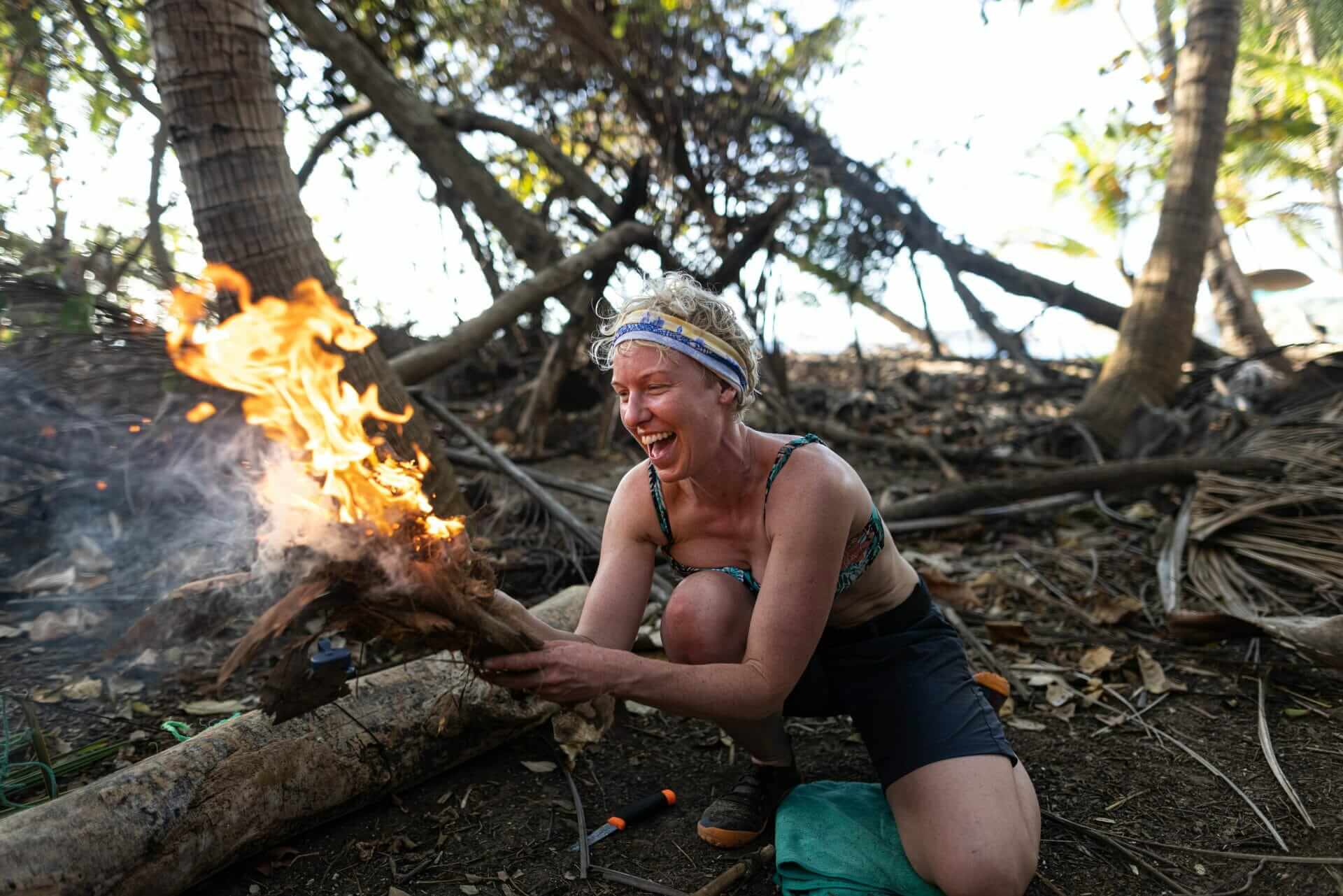
How to Make a Fire in the Wilderness
Creating a campfire is one of the many important skill to survive on a desert island. Making fire is a skill as old as humanity itself, yet it’s about more than just sparks and fuel. It’s about understanding your surroundings, selecting materials, preparation and nurturing the flame. For a basic understanding of essential survival gear, see our article on 3 Things to Bring on a Deserted Island.
How to make a fire by friction is one of the core skills we teach during our island survival classes, but we wanted to share some tips and pointers below.

Understanding The Physics of Fire and How to Start a Flame
To combust (burn), a fire needs three things: heat, fuel and oxygen. This is called the fire triangle. If your fire is not taking, then one of these three is lacking. For example, if your wood is wet all heat is being absorbed by the water, stopping the fuel from hitting a high enough temperature.
Everything has its burning point, the temperature it combusts. Soft woods burn at far lower temperatures than hard woods.
In addition, not all firewood is created equal. Different woods burn at different temperatures. Some spit, some give out better smoke than others, and some make better embers for cooking on.
Best Types of Wood to Build a Fire in the Wild
The below chart from Juan Pablo Quiñonez’s fantastic book Thrive brings to life this concept well.
| Tree | Advantage | Disadvantage | Smoke | Kindling | Other |
|---|---|---|---|---|---|
| Willow (Salix) | The nicest fuel: pleasant smoke, bright flame, good heat and embers, easily gathered without tools. | Found in thin pieces that burn quickly. | Pleasant. | Good. | Great for friction fire. |
| Trembling aspen (Populus tremuloides) | Available in large, long-burning logs, and it can be burned green. | It can be hard to cut. | Slightly irritating for the eyes. | Dry wood makes good feather sticks. | |
| Tamarack or larch (Larix) | Burns very hot. | Only available in winter due to wet ground. | Moderate. | Roots smolder and can be a fire hazard. | |
| Alder (Alnus) | Easily gathered and broken without tools. | Burns up the fastest. | Very little. | Green alder is good for smoking meat. | |
| White spruce (Picea glauca) | Large logs make the longest-lasting and strongest heat. | It can be hard to cut. | Bad. | Resin and twigs are good for fire lighting. | |
| Jack pine and lodgepole pine | Strong heat and fast burning. | Strongly irritating smoke. | Very smoky and irritating. | Red needles are good, water-resistant tinder. | |
| Driftwood | Very hot, burning even if wet. | Coastal driftwood (salt) releases toxins when burnt. | Moderate. | ||
| Birch (Betula) | The hottest, nicest-smelling firewood. Burns when green. | Found mostly rotten or green. | Pleasant smoke. | Its bark makes excellent tinder, burns even when wet. | Host of false tinder fungus and chaga. |
Gathering Materials for Bushcraft Fire Fuelling
To build a fire, you need three types of materials: tinder, kindling, and firewood. Each plays a crucial role in the fire-making process.
Tinder
What is Tinder? Tinder is a collection of light, dry material that catches fire easily. Good tinder is anything dry light and airy to allow plenty of oxygen. It can be dry grass, fluffy seed pods, even dry leaves. It burns fast, generating enough heat to ignite kindling, the next step.
On a desert island, the best tinder can be found inside mature coconuts. It’s always dry.
Tip: ‘Buff’ your tinder by rubbing it together to ensure it has lots of frayed ends which will make taking a spark easier.
Tip 2: Always be on the lookout for new Tinder. Fill your pockets with anything that looks like it might work and test them out next time you are starting a fire.
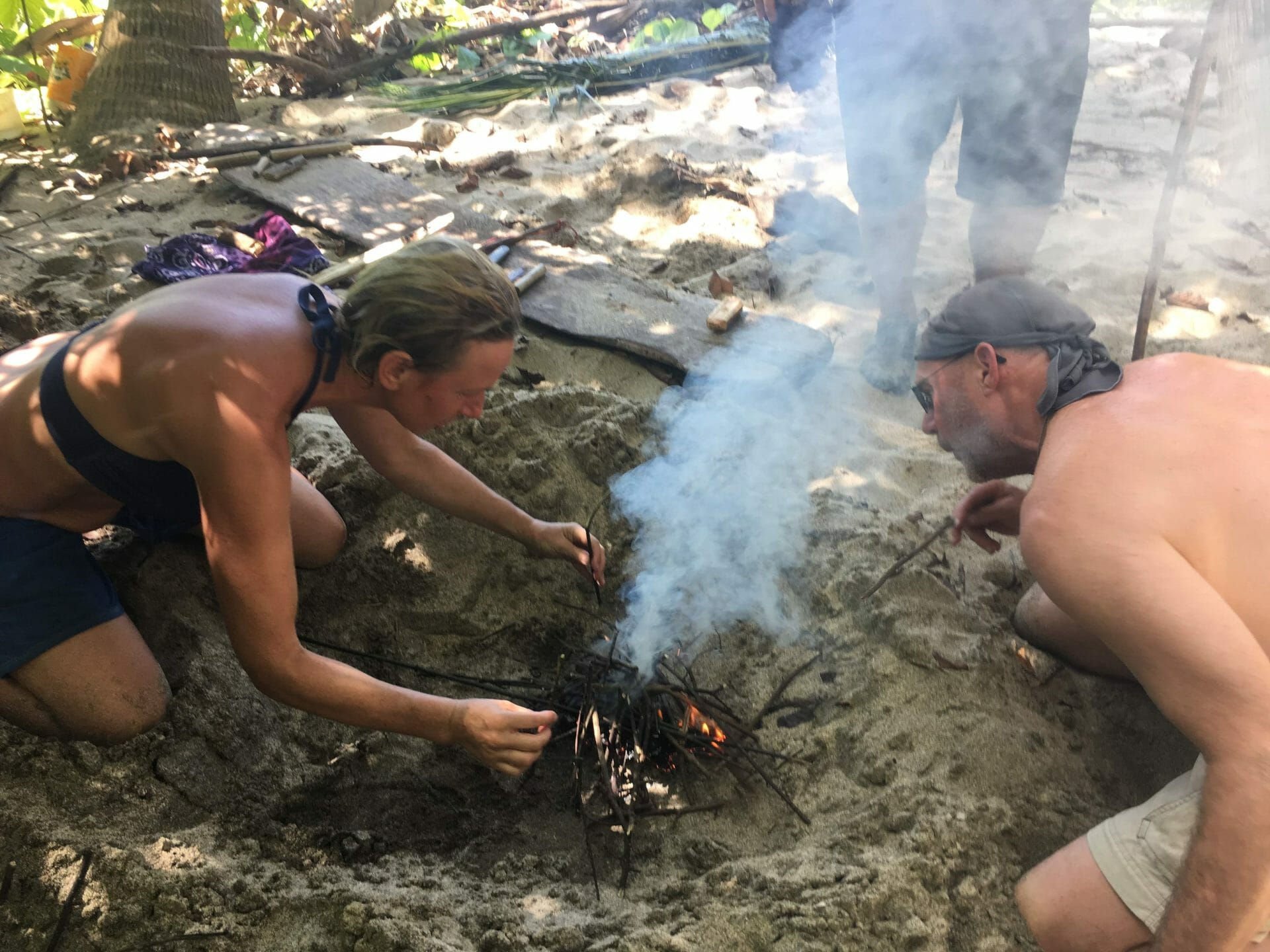
Kindling
Kindling refers to small sticks, small twigs, and small pieces of bark. As Tinder burns and starts to fade, the kindling catches fire, providing a more sustainable flame. Its role is to bridge the gap between the rapidly burning tinder and the longer-lasting firewood.
We like the expression toothpicks to tree trunks. Kindling is your toothpicks, and you move up in circumference from there.
Firewood
Firewood, the third component, consists of larger logs, big logs of fuel wood that will burn longer. It’s the main course, providing substantial heat and a sustained burn.
Gathering wood is an important step. Collect wood from downed trees or dead branches, making sure it’s dry wood, not green and not rotten. Rotten will burn fine but only last a short time.
Even in a rainstorm, dry wood can typically be found in the core of vertical standing dead wood.
Talking about wood, check out our guide on How to Build a Shelter.
How to Build Your Fire Structure
There are several methods to build a fire, such as the log cabin and the teepee structure. For beginners, the teepee campfire method is simple and effective.
Begin by arranging your tinder in the centre of the fire bed. The tinder bundle should be loosely packed to allow air to flow. Now, create a teepee structure by arranging small sticks dry bark and twigs around the tinder, leaving a gap to add your burning tinder to light the fire.
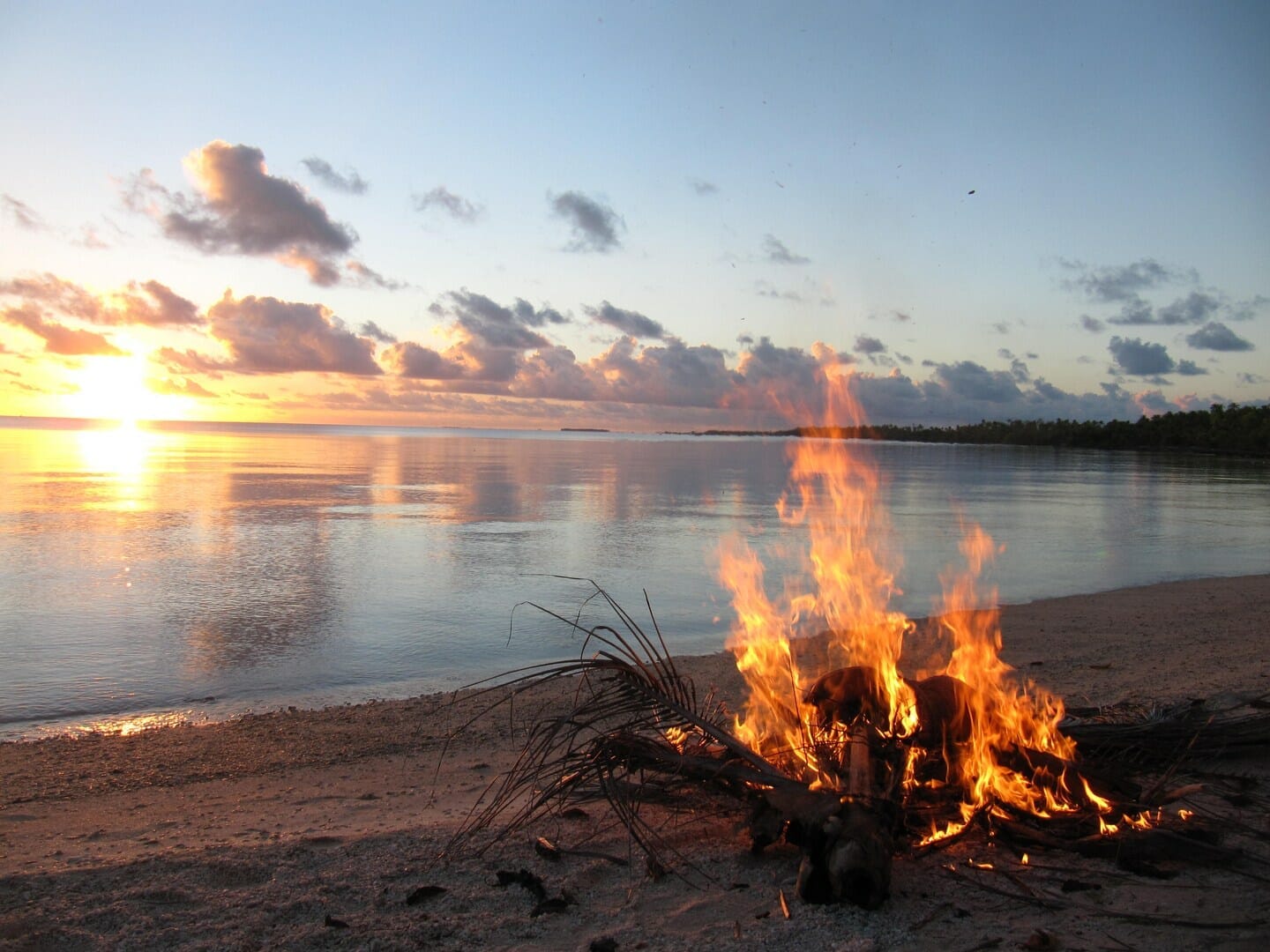
Preparing Your Fire Site: Safeguarding the Wilderness
Once you’ve gathered your materials, your next task is to prepare your own fire ring or site.
Choose a spot away from low-hanging branches, ensuring a safe distance from flammable materials.
Look for a flat ground clear of grass and dry leaves. It’s important that your fire ring or fire pit is surrounded by bare earth or stones.
To lay the groundwork, start a fire first by clearing a space of about 2 feet in diameter. Then create a fire bed using a layer of dry, non-combustible material such as sand or small stones. On this bed, you’ll build your fire lay.
If you are in a particularly fire-prone environment, have a bucket of sand on hand.
How to Start the Fire in the Wild: The Spark of Survival
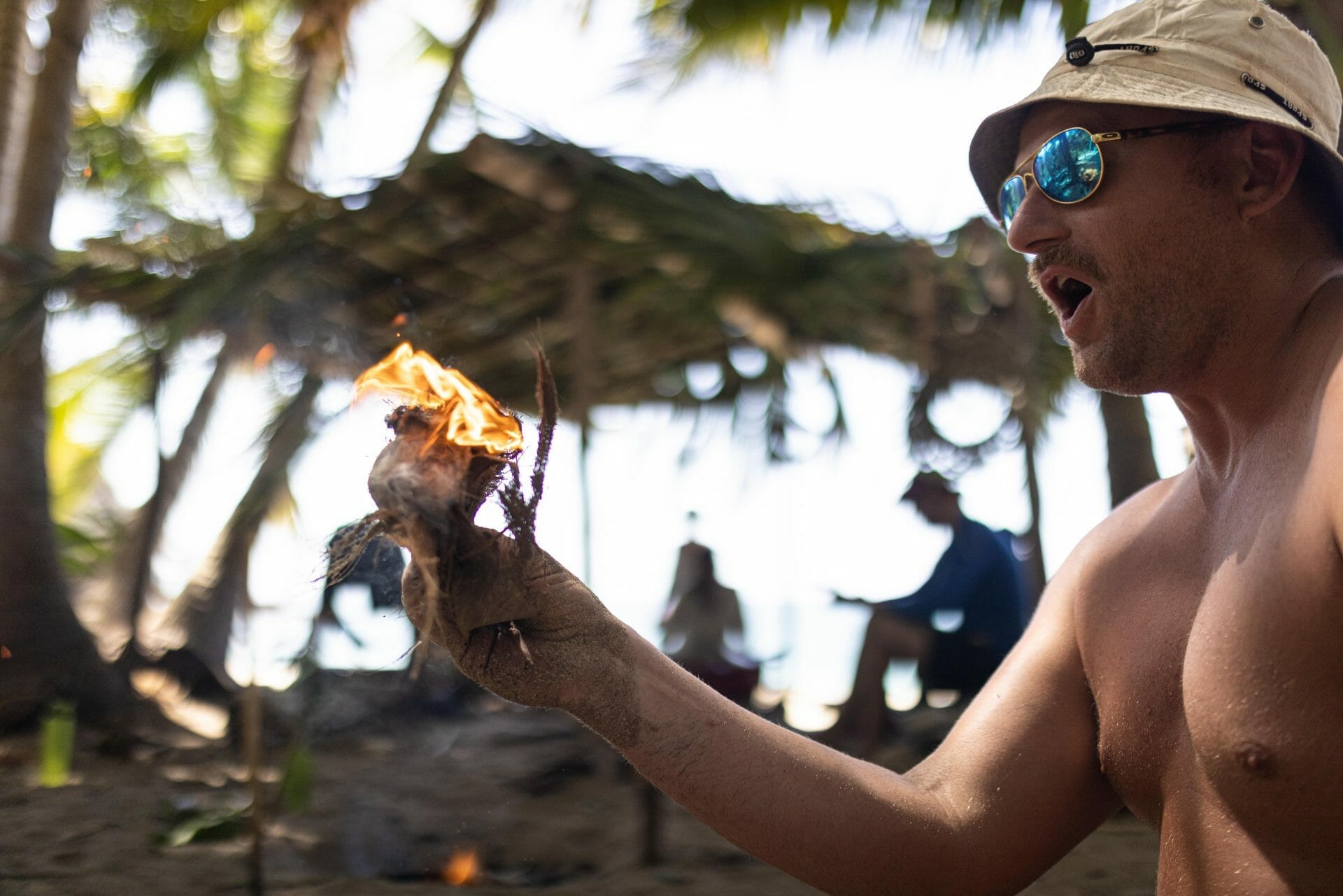
The Age-Old Art: Flint and Steel
Ok let’s discuss actually how to make fire. One of the oldest methods for creating fire is flint and steel. This technique relies on striking two pieces of material together to generate sparks.
Flint, a type of quartz, is known for its ability to produce sparks when struck against steel. The sparks are then caught on a piece of char cloth, a piece of fabric that has been turned into charcoal. The ember can then be transferred to a tinder nest and gently blown into flame.
Using fire steel or Ferro rod
Nowadays most survival kits include a Ferro rod. This man-made material, Ferrocerium is exceptional. Generating a sparks shower at 5,500 F (3,000 C) which will even work when wet.
The ferro rod should be scraped with a 90-degree angle to produce a shower which should be concentrated on a tinder bundle that will ignite without too much difficulty.
Tip: you can scrape the ferro rod to create a pile of fust from it on the tinder, then with a large strike you can ignite this area of scrapings.
If you are looking for an excellent ferro rod we recommend a large 6-inch rod with a striker by bayite striker.
Most popular: Rubbing Sticks to Make Fire
While flint and steel have their charm, creating a friction fire is truly getting back to basics. This method involves rubbing two pieces of wood together to generate enough heat to form an ember.
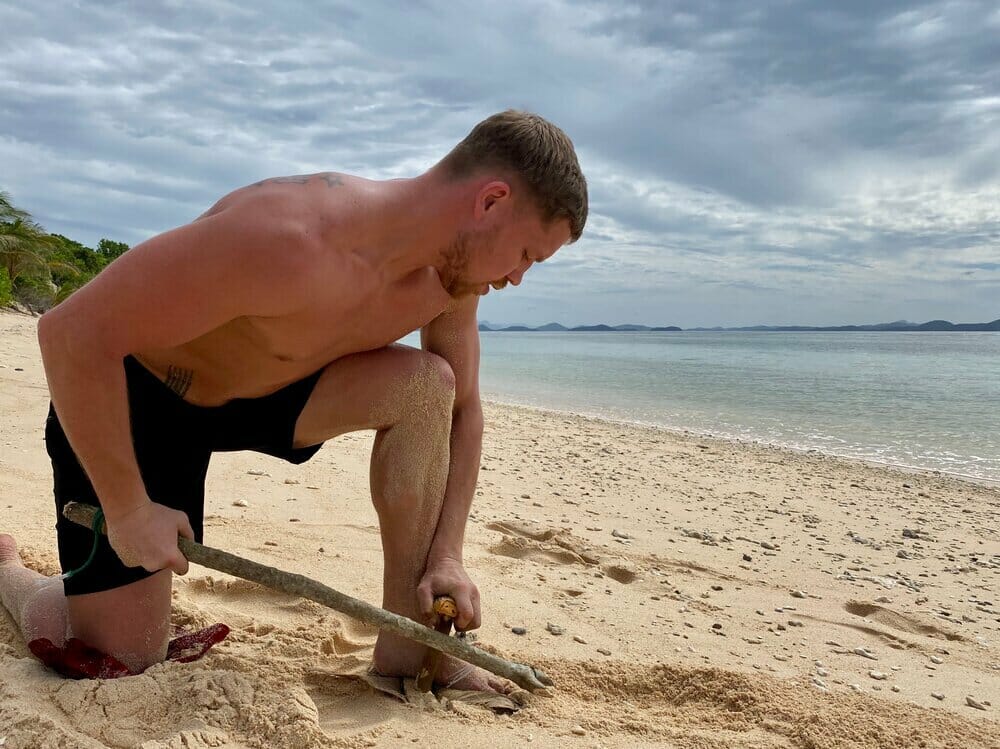
One of the most popular friction methods is the bow drill fire. A bow drill kit consists of 5 parts. A bow, a drill or spindle, a fireboard or base, and a bearing block or handhold.
The drill is spun against the fireboard using the bow, creating friction and heat. A small notch in the fireboard catches the hot wood dust created, which eventually forms an ember. On the island, we also teach the hand drill and bamboo fire saw.
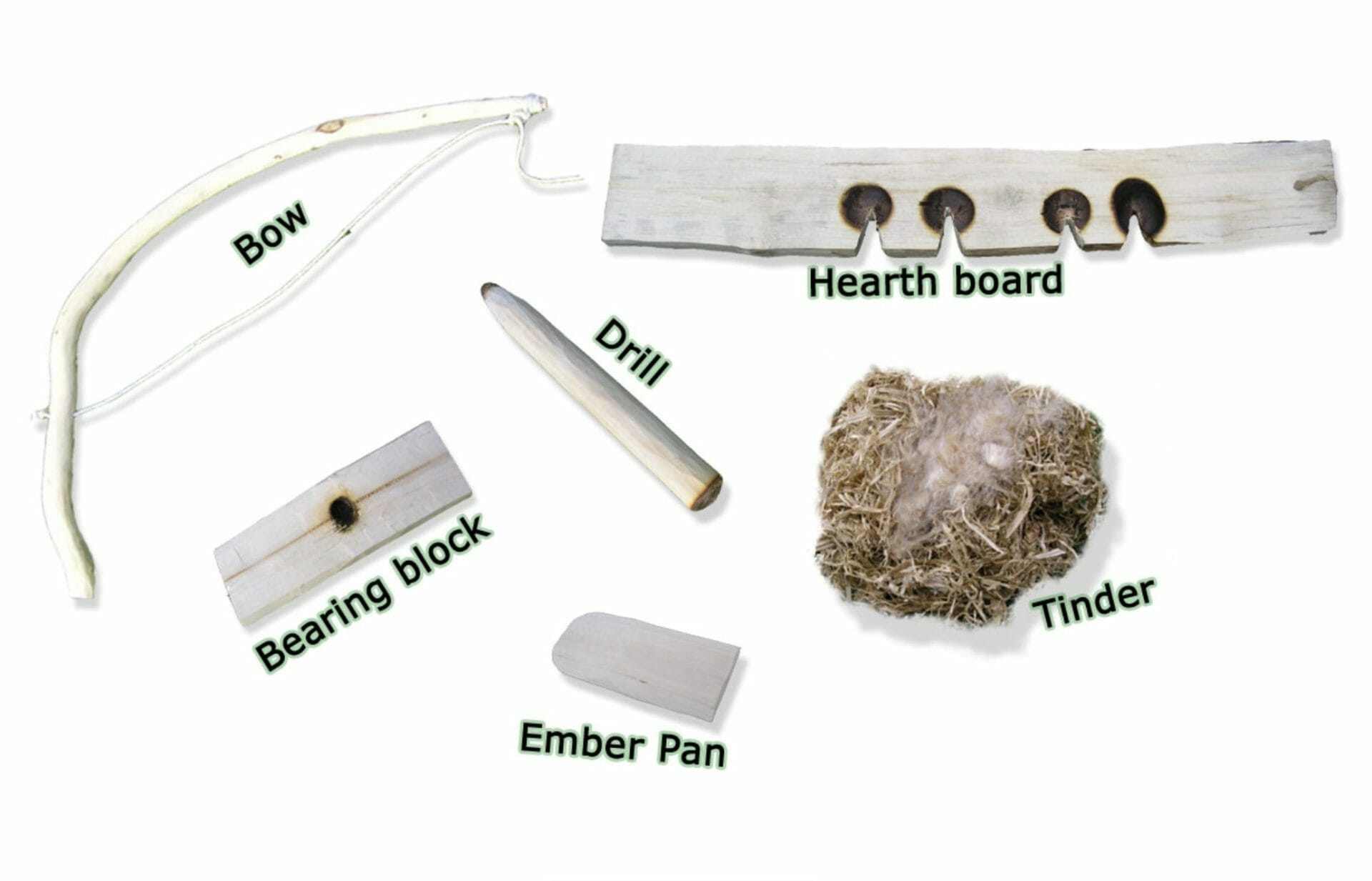
Nature’s Gift: Naturally flammable oils
In the wilderness, fungus, birch bark, and pine needles make for excellent natural fire starters due to their flammable oils. These can be especially useful in damp or wet conditions, where finding dry tinder can be a challenge.
One of the best options is fat wood, found in coniferous trees. This will burn like lantern oil.
Harnessing the Sun: Magnifying Glass
If you’ve ever used a magnifying glass to focus sunlight on a piece of paper, you’ve witnessed the power of solar ignition. This method can be used to ignite tinder, given sunny conditions.
A magnifying glass, eyeglasses, or any clear, curved lens can be used to focus the sunlight on your tinder nest, creating a concentrated beam of heat that can ignite the material. We have even achieved this with plastic bottles, clear plastic bags and even a lightbulb we found on the beach.
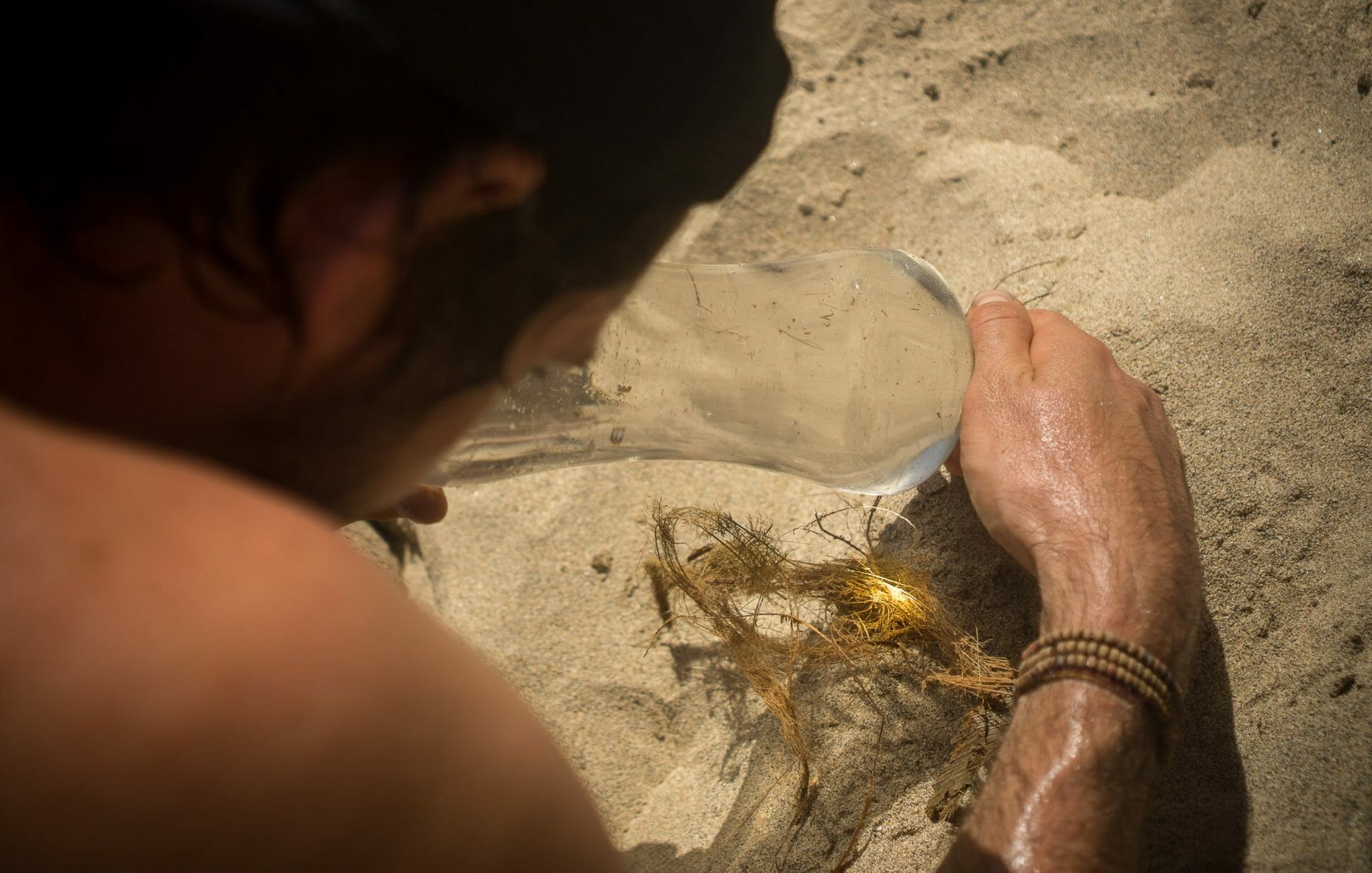
Modern Wilderness Survival: Batteries and Steel Wool
Imagine being stuck in the wilderness with only a dead flashlight and a small bag of steel wool. Unlikely as it seems, you have the makings of a fire. When stretched out and connected to the positive and negative terminals of a battery, the fine steel fibres of the wool will begin to glow and smoulder. This can be used to ignite your tinder and create a warming fire.
Now it’s time to light your kindling. Add your burning tinder to your teepee structure, and gently blow at the base to provide oxygen to fuel the fire.
Once the kindling catches fire and starts burning, add more wood and a few more layers of kindling white ash and firewood, maintaining the teepee structure. The small fire should gradually grow larger.
As the flame becomes steady, you can add bigger sticks, followed by larger logs, arranged in a crisscross pattern to allow more light and good airflow.
How to Get a Fire Going: Nurturing the Fuel and Flame
Building a fire is only the beginning. To keep it burning, you need to feed it more wood, preferably dry, fuel wood.
Start with smaller pieces dry downed wood, such as small twigs, and gradually add larger pieces of wood, maintaining the flame.
Feed the fire, but don’t smother it. Balance is key. Allow for airflow between pieces of wood, helping the flame to breathe and burn brightly.
Remember, the aim of good campfire is a long, steady burn, not a short-lively inferno.
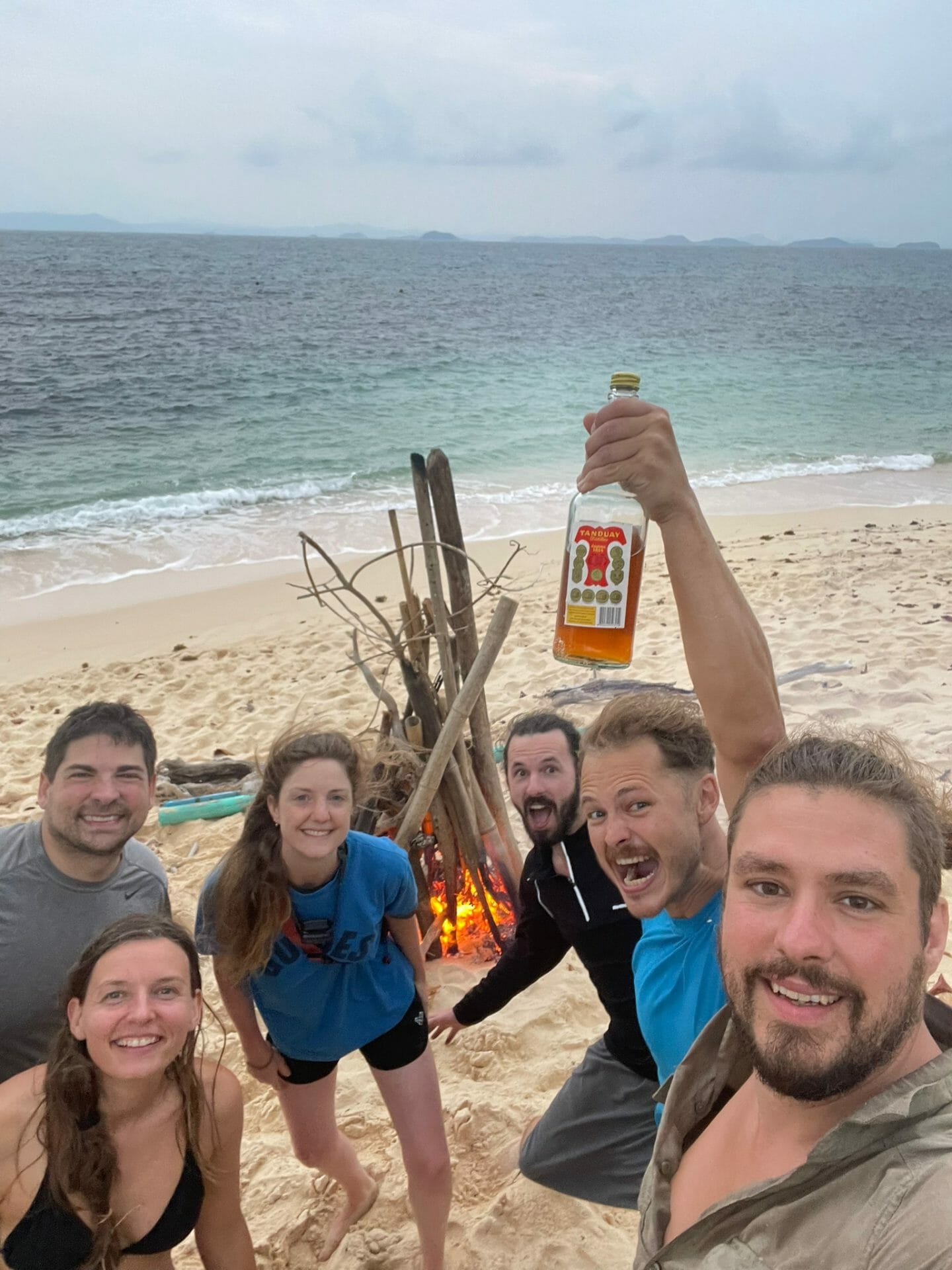
Managing the Fire: The Responsible Wilderness Guardian
Fire can be both a lifeline and a threat to wild animals in the wild. That’s why it’s crucial to control your fire and respect the surrounding area.
Remember, it’s a bad idea to leave a fire unattended. If you need to step away, ensure your fire is safely extinguished. You can use dirt, sand or water.
When using dirt or sand, shovel it onto the hot embers until completely covered. It will starve the fire of its oxygen.
When pouring water, sprinkle it gently to avoid scattering hot embers. Continue to sprinkle water and poke holes into the soil or sand until the ground feels cool to touch, and there are no more hissing noises.
Then kick dirt over where the fire pit used to be to remove all trace of a fire ever being there.
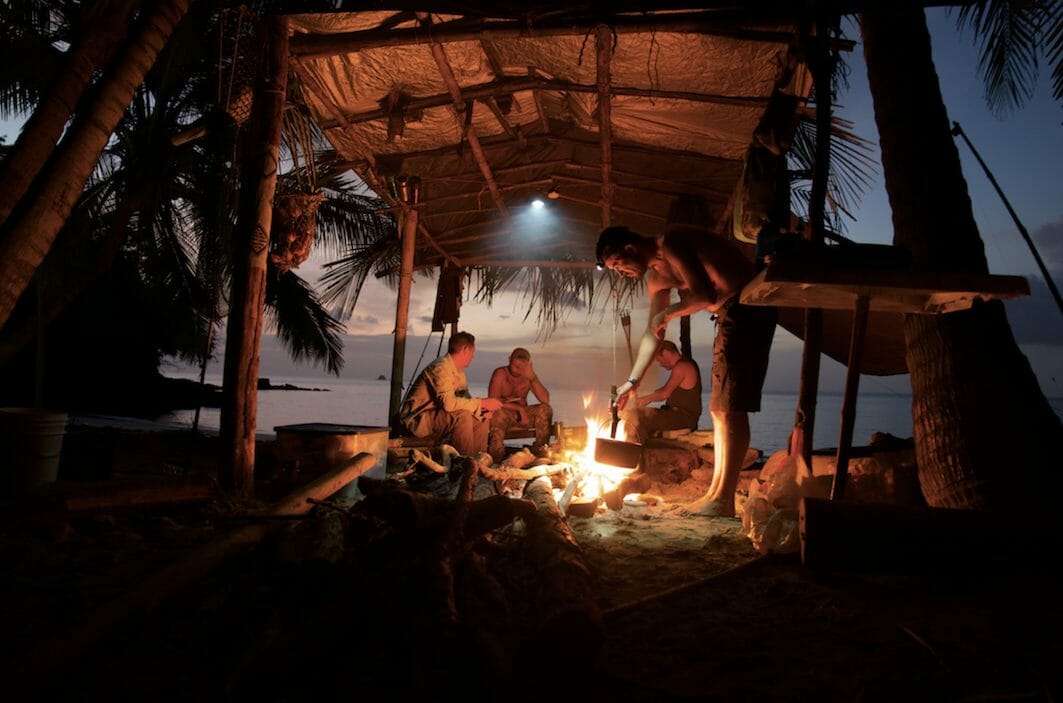
Making Fire in the Rain: The Art of Wet Weather Fire-Making
One of the most challenging survival scenarios is starting a fire in the rain. Everything is soaked, and it seems impossible to find dry tinder. But what makes one thing more difficult, gives us another important thing: water. Learn more on How to Find Water on an island. Back to fire making, with the right techniques and a little patience, fire can be achieved even in the rain.
Firstly, look for standing deadwood. Dead branches that are still attached to trees are often drier than wood on the ground.
Underneath the bark of these branches, or splitting them and using their core, you will typically find dry wood. You can run your knife down wood to create feather sticks, spindly thin wood that will take an ember.
Next, look for resin-rich wood, like pine. Even when wet, resinous wood can burn, and with enough heat, it will eventually dry out and ignite.
Tip: You can assess the moisture content of wood by putting it to your lips, they are the most sensitive part of your body for detecting moisture.
Summary: 8 Tips for Making a Fire in the Wild with Nothing
- Learn different wood species and which is best for different needs.
- Wood needs to be as dry as possible. Dead-standing wood is best.
- In a rainstorm split open dead-standing wood and scrape it core into feather sticks.
- before starting to make a fire, be sure to prepare first. Get your tinder kindling and fuel ready before trying to ignite.
- Remember the Fire triangle. Oxygen, Heat Fuel and refer back to it when a fire is not taking.
- Collect tinder whenever you have the chance and store it somewhere dry.
- Friction fires are all about technique, if possible practice on an already proven working kit to get the technique dialled in.
- Practice safe fire making. Look out for overhead branches and always keep your fire a manageable size. When extinguishing a fire pour water on it and poke holes in the ground to cool the earth too.
So, now that you know how to make a fire, what about food? Read our blog on How to Fish Without Gear or join one of our expeditions. If you’re not sure which destination to choose, we’ve created this great little quiz to help you.


